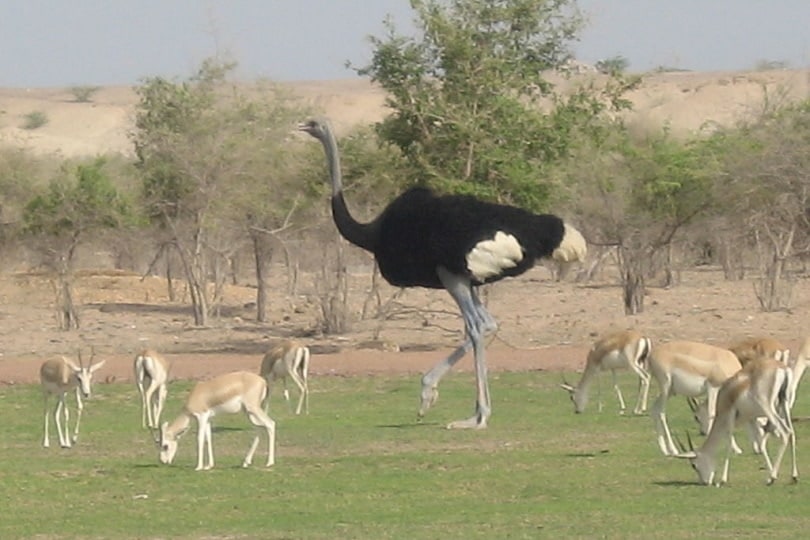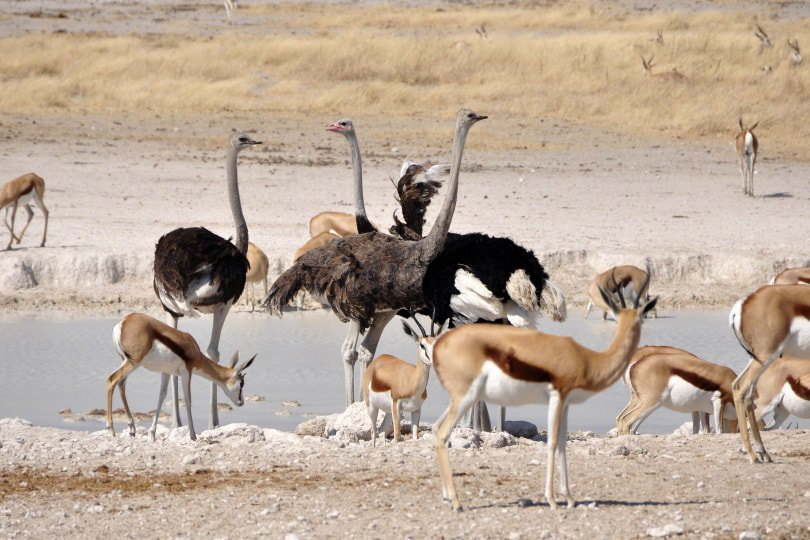Gazelles and ostriches are two very different animals. The ostrich is a large, flightless bird, while the gazelle is a small and slender creature in the antelope species.
While they might not have much in common, the gazelle and ostrich need each other in the wild. They have a symbiotic relationship with one another and it’s this relationship that keeps both species alive and thriving.
Keep reading to learn everything you need to know about their symbiotic relationship.

What Are Mutualism and Symbiosis?
Symbiosis, in literal terms, means living together and refers to long-term biological interactions between two organisms. Symbiosis can refer to three different relationships between organisms:
- Mutualistic (ecological interaction between at least two animal or plant species where each benefit from one another),
- Commensal (where one species gains benefits while the other neither benefits nor is harmed by the relationship),
- Parasitic (where a parasite lives on or inside another organism).
Since the gazelle and ostrich have a mutualistic relationship, that’s what we’ll be focusing on in this article.
Despite the difference in definition, mutualistic and symbiotic relationships have been used interchangeably.
Mutualism acts as a very key player in ecology and evolution. It occurs in every aquatic and terrestrial habitat. In fact, most ecologists believe that nearly every species on Earth is involved in some type of mutualistic interaction. It’s vital to the reproduction of many different plant and animal species.
Perhaps the most easily recognizable mutualistic relationship is that between a bee and a flower. Bees fly from flower to flower to gather nectar. They use this nectar to make their food. When bees land on a flower, pollen from the flower attaches to their body which they then transfer onto the next flower they land on. This is a process known as pollination which benefits the plants as they then can reproduce.

How Do Gazelles and Ostriches Benefit One Another?

Gazelles and ostriches feed next to one another in the wild. They both watch for predators using their heightened senses and can alert the other when danger is nearby. Both species can identify predators and threats that the other would not notice in time to save themselves.
Ostriches have very keen eyesight which makes up for their very poor hearing and sense of smell. Since they can see so far, they’re able to spot predators that other animal species might not see until it’s too late. Their height gives them a great advantage, too, as they can see over the top of shrubs, grass, and other foliage.
Gazelles also have great eyesight, but they’re at a disadvantage since they’re not as tall as ostriches. They have a keen sense of smell and hearing so they can sniff out and hear predators that ostriches could not.
When an ostrich sees a predator approaching over foliage that gazelles cannot see over, they will flee. When the gazelles see the ostriches fleeing, they know it’s time for them to escape, too.
When a gazelle hears or smells a predator nearby, they’ll flee, alerting the ostrich that danger is afoot and that they should flee, too.
- See Also: Rhea vs Ostrich: What’s the Difference?

Final Thoughts
The animal kingdom is an interesting place with many different symbiotic relationships to observe. It only makes sense that over time species have learned to work with one another to survive, especially in the case of commonly preyed upon animals like ostriches and gazelles. Without their mutualistic relationship, these two species would not have been able to survive as long as they have.
Featured Image Credit: Pxhere
